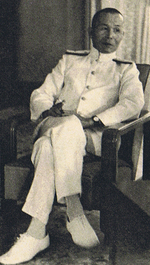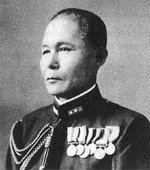Jisaburo Ozawa
| Surname | Ozawa |
| Given Name | Jisaburo |
| Born | 2 Oct 1886 |
| Died | 9 Nov 1966 |
| Country | Japan |
| Category | Military-Sea |
| Gender | Male |
Contributor: C. Peter Chen
ww2dbaseJisaburo Ozawa graduated from the Imperial Naval Academy in 1909. He was a professor at the academy in the mid-1930s, but it was not before long when he was activated for sea-going duties as war. Between 1935 and 1937, he served as the commanding officer of light cruiser Maya and then battleship Haruna. He was promoted to the rank of rear admiral in 1936. Between 1937 and 1938, served as the chief of staff of the Combined Fleet. Between 1938 and 1941, he served as commanding officer of various naval units before being recalled to the Navy General Headquarters in 1941 as a staff officer. He was promoted to the rank of vice admiral in 1940. Nicknamed "the Gargoyle", he was considered among the ugliest flag officers in the Japanese Navy, but people who served under him found him to be a compassionate officer and a fine tactician. Starting in Nov 1942, his responsibilities grew tremendously, serving as commander in chief of Third Fleet until Mar 1944, vice chief of the Navy General Headquarters for eight months, then finally the commander in chief of the Combined Fleet until near the end of the war. Due to problems that had already taken place before his tenure as the head of the Combined Fleet, his service was haunted by an uninterrupted series of losses to the American naval forces. In Jun 1944, he commanded the fleet that faced the US 5th Fleet in the Battle of the Philippine Sea, in which Japan suffered a complete defeat, losing nearly 400 aircraft; withdrawing to Okinawa, he submitted his resignation letter, but it was rejected. During the Leyte campaign, his carrier fleet served little more than a bait force, flight decks empty for lack of available aircraft. Nevertheless, Ozawa played his role intelligently and professionally until the end.
ww2dbaseAfter the war, Ozawa was interrogated by Rear Admiral R. A. Ofstie of the United States Navy and Lieutenant Commander J. A. Field, Jr. of the United States Naval Reserves in Tokyo on 30 Oct 1945. They commented Ozawa as "an officer of impressive personality, dignified presence, and thoughtful habit of mind. While his memory for fine detail was not always precise his opinions were considered of the highest value." At the end of the interrogation, he offered his opinion that "[i]t is my opinion that this war should never have taken place." However, if war was to be considered unavoidable, he attributed Japan's defeat to the inability to manufacture adequate supply of aircraft and the failure to improve electronic devices.
ww2dbaseSources: Interrogations of Japanese Officials, Nihon Kaigun, Wikipedia.
Last Major Revision: Mar 2007
Jisaburo Ozawa Interactive Map
Photographs
 |  |
Jisaburo Ozawa Timeline
| 2 Oct 1886 | Jisaburo Ozawa was born. |
| 18 Feb 1937 | Jisaburo Ozawa was named the chief of staff of the Japanese Navy Combined Fleet. |
| 1 Apr 1942 | Vice Admiral Jisaburo Ozawa's Malaya Force, Second Expeditionary Fleet, departs Mergui, Burma and steams into the Bay of Bengal in the Indian Ocean Raids to attack merchant shipping. The force includes light carrier Ryujo and cruisers Chokai, Suzuya, Kumano, Mikuma, Mogami, and Yura. |
| 5 Apr 1942 | Following Admiral Jisaburo Ozawa’s force’s attack on the British naval base at Colombo, Ceylon, the force is split creating a Northern Group commanded by Rear Admiral Takeo Kurita consisting of cruisers Kumano and Suzuya; the Center Group consisting of the carrier Ryujo and cruisers Chokai and Yura under Ozawa; and the Southern Group comprised of cruisers Mogami, and Mikuma under Captain Shakao Sakiyama for the purposes of smaller raids against merchant shipping. |
| 11 Apr 1942 | Jisaburo Ozawa's Force arrived at Singapore to conclude a successful sortie into the Indian Ocean. |
| 18 Sep 1943 | Yamato, Nagato, Shokaku, Zuikaku, Takao, Atago, Myoko, Haguro, and a destroyer screen sortied from Truk, Caroline Islands to Brown Island (Eniwetok), Marshall Islands with Combined Fleet under Vice Admiral Jisaburo Ozawa's tactical command in response to the US Task Force 15 carrier raids on Tarawa and Makin. |
| 19 Jun 1944 | At dawn, flagship Taiho, Shokaku, and Zuikaku launched launched combat air patrol fighters. At 0756 hours, the first major strike force was launched (48 fighters, 53 bombers, and 27 torpedo bombers; led by Lieutenant Commander Akira Tarui). At 0810 hours, USS Albacore hit Taiho with a torpedo in the starboard bow, but Taiho's damage control team allowed the carrier to remain in formation; destroyer Hatsuzuki was left behind to hunt for USS Albacore. At 1020 hours, Zuikaku launched a second strike force (4 fighters and 4 bombers) to join the fourth big raid on on US Navy Task Force 58. Meanwhile, Taiho suspended flight operations due to gas vapor issues and Shokaku was busy with combat air patrol duties through well past 1100 hours. At 1100 hours, Shokaku began recovering 10 fighters; while the recovery process continued, at 1122, Shokaku was hit by three torpedoes from USS Cavalla on the starboard side; two forward near the switchboard and generator room, one aft of amidships. Large fuel fires were ignited in the hangar and No. 1 boiler room went offline. Shokaku remained underway, but began to list to starboard. Counterflooding over-compensated, giving her a port list. Meanwhile flooding and heat of the fires forced shutting down of the boiler rooms. She continued to settle forward. Though damage control initially hoped to save her, the flooding forward and the fires intensify in the following hours. By 1210 hours Shokaku had come to a halt when fires detonate an aerial bomb on the hangar, setting off volatile gases from a cracked forward tank. Large induced explosions wrecked the carrier, and hope began to fade. The list to port and bow trim both increased. Carriers Zuikaku and Taiho were ordered to leave damaged Shokaku behind, while cruiser Yahagi and destroyer Urakaze remained with Shokaku. At 1350 hours, Shokaku strike planes returned, but were ordered away, redirected to Zuikaku and Taiho. By the time Taiho's aircraft returned, the gas vapor leak problem became extremely worrisome, and some of Taiho's aircraft were redirected to Zuikaku. At this time Captain Hiroshi Matsubara of Shokaku had ordered the carrrier abandoned and the crew mustered on the flight deck for flag lowering. However, before the evacuation can proceed far, the bow dipped under and water pours into No. 1 elevator well, causing the carrier to corkscew to port and up-end. Shokaku went down by the bow at 1401 hours, stern raised high. Between 1408 and 1411, four underwater explosions were registered. 58 officers, 830 petty officers and men, 376 members of Air Group 601, and 8 civilians were killed, totalling 1,272 deaths in the sinking of Shokaku. Light cruiser Yahagi and destroyers Urakaze and Hatsuzuki rescued Captain Hiroshi Matsubara among 570 other survivors. At 1432, another disaster struck as the gas vapor aboard Taiho detonated; the explosion engulfed the flagship. Zuikaku was ordered to proceed while Vice Admiral Jisaburo Ozawa to transferred his flag to cruiser Haguro. At the end of the day, the Japanese Navy lost 244 of the 374 aircraft that it had launched during this battle. The US Navy had only lost 20 aircraft. |
| 25 Oct 1944 | Off northeastern Luzon, Philippines, aircraft from US Navy Task Force 38 attacked the Japanese carrier force consisted of fleet carrier Zuikaku and light carriers Zuiho, Chitose, and Chiyoda in the Battle off Cape Engaño. The Japanese force was escorted by two battleship-carrier hybrids (Hyuga and Ise; aircraft-less on this date), three light cruisers (Oyodo, Tama, and Isuzu), and nine destroyers at about 0830 hours, 26 minutes after those planes were detected by Zuikaku's radar. The overwhelmingly larger American force, under Admiral William Halsey, centered around fleet carriers USS Lexington, USS Intrepid, USS Essex, USS Franklin, USS Enterprise, further bolstered by a great many light carriers, battleships, cruisers, and destroyers. Zuikaku was damaged by skilled damage control teams extinguished the fires and corrected the listing by 0850 hours. Chitose was fatally damaged by the first attack wave, sinking at 0937 hours. At 0953 hours, a second attack wave struck, fatally damaging Chiyoda, leaving her dead in the water to be sunk by American destroyers later at 1655 hours. The second wave also damaged Zuiho's flight deck, the last functional flight deck of Vice Admiral Jisaburo Ozawa's force; Japanese combat air patrol planes in the air would need to ditch when they ran out of fuel. At 1032 hours, Ozawa transferred his flag from the damaged Zuikaku to Oyodo. At 1308, the Japanese sighted an incoming third wave of American aircraft. Six torpedoes struck Zuikaku, causing massive flooding and several fires in the hangar; the commanding officer addressed the surviving crew, ordered the lowering of the ensign, and gave the abandon ship order at 1358 hours; Zuikaku sank by the stern at 1414 hours. Zuiho suffered two torpedo, two bomb hits, and a great many near-misses during the third attack wave, and she was dead in the water at 1445 hours. At 1455 hours, a fourth wave struck, sealing the doom of Zuiho with ten near-misses, leading to Zuiho's commanding officer giving the abandon ship order; she sank at 1526 hours. |
| 29 May 1945 | Jisaburo Ozawa was named the commander-in-chief of the Japanese Navy Combined Fleet. |
| 25 Jun 1945 | Vice Admiral Jisaburo Ozawa ordered a special attack on the American anchorage at Ulithi, Caroline Islands. Operation Hikari was planned to use submarines I-13 and I-14 to bring Saiun aircraft over Ulithi for reconnaissance. Operation Arashi would then have submarines I-400 and I-401 bring Seiran aircraft to perform special attacks on American ships if the conditions were favorable. Kaiten special attack submarines were to attack at the same time as well. |
| 9 Nov 1966 | Jisaburo Ozawa passed away. |
Please consider supporting us on Patreon. Even $1 per month will go a long way! Thank you. Please help us spread the word: Stay updated with WW2DB: |
Visitor Submitted Comments
5 Apr 2021 06:15:53 PM
how did he die?
All visitor submitted comments are opinions of those making the submissions and do not reflect views of WW2DB.

» Dutch East Indies Campaign, Java
» Dutch East Indies Campaign, Sumatra
» Raids into the Indian Ocean
» Mariana Islands Campaign
» Philippines Campaign, Phase 1, the Leyte Campaign
Ship(s) Served:
» Haruna
» Kashii
» Maya
» Oyodo
» Ryuho
» Taiho
Document(s):
» Interrogation Nav 55, Vice Admiral Jisaburo Ozawa
- » 1,182 biographies
- » 337 events
- » 45,119 timeline entries
- » 1,249 ships
- » 350 aircraft models
- » 207 vehicle models
- » 376 weapon models
- » 123 historical documents
- » 261 facilities
- » 470 book reviews
- » 28,412 photos
- » 365 maps
Fleet Admiral Chester W. Nimitz, 16 Mar 1945
27 Aug 2013 09:20:39 PM
Was J. Ozawa related to Tadaharu and Takeo Ozawa? They were Japanese army generals.
http://www.generals.dk/general/Ozawa/Tadaharu/Japan.html
http://www.generals.dk/general/Ozawa/Takeo/Japan.html